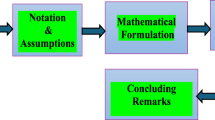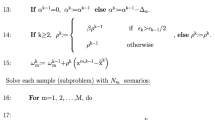Abstract
We consider a fashion discounter distributing its many branches with integral multiples from a set of available lot-types. For the problem of approximating the branch and size dependent demand using those lots we propose a tailored exact column generation approach assisted by fast algorithms for intrinsic subproblems, which turns out to be very efficient on our real-world instances as well as on random instances.








Similar content being viewed by others
Notes
E.g. for 12 different sizes, which is reasonable for lingerie or children’s clothing, there are \(1\,159\,533\,584\) different lot-types, if we assume that there should be at most 5 items of each size and that the total number of items in a lot-type should be between 12 and 30.
In various applications with tight models, the procedure is stopped at this point because one hopes that the integrality gap is so small that further effort need not be spent (see, e.g., Krumke et al. (2002)). ASG can be seen as extending this into an exact algorithm finding the optimum ILP solution.
We remark that one can express the deviations \(\delta _{b,s}^a\) also using the binary assignment variables \(x_{b,i,m}\) instead of the item counts \(v_{b,s,i,m}\). In this case we have to replace the two inequalities containing \(\delta _{b,s}^a\) by \(\delta _{b,s}^a+m\cdot l_{i,s}-d_{b,s}^a\cdot x_{b,i,m} \ge 0\) and \(\delta _{b,s}^a-m\cdot l_{i,s}+m\cdot max_c\cdot \left( 1- x_{b,i,m}\right) \ge -d_{b,s}^a\) for all \((b,s,m,i)\in {\mathcal {U}}, a\in {\mathcal {A}}\). Or we may use both sets of inequalities.
Assuming some technical conditions on the demands, the four parameters for the lot-types, and the applicable multiplicities, which are not too restricting, one can construct a solution of the LP relaxation having an objective value of zero. E.g. we assume \(\min _c\le d_{b,s}^a\le \max _c\cdot \max \{m\in {\mathcal {M}}\}\)
References
Agra A, Cerdeira JO, Requejo C (2017) A decomposition approach for the \(p\)-median problem on disconnected graphs. Comput Oper Res 86:79–85
Ahsan K, Azeem A (2010) Insights of apparel supply chain operations: a case study. Int J Integr Supply Manag 5(4):322–343
Aouad A, Farias V, Levi R, Segev D (2018) The approximability of assortment optimization under ranking preferences. Oper Res 66(6):1661–1669
Avella P, Sassano A, Vasilyev I (2007) Computational study of large-scale \(p\)-median problems. Math Program 109(1):89–114
Barnhart C, Johnson EL, Nemhauser GL, Savelsbergh MWP, Vance PH (1998) Branch-and-price: column generation for solving huge integer programs. Oper Res 46(3):316–329
Birge JR, Louveaux F (2011) Introduction to stochastic programming, vol xxv, 2nd edn. Springer series in operations research and financial engineering. Springer, New York, p 485
Boccia M, Sforza A, Sterle C, Vasilyev I (2008) A cut and branch approach for the capacitated \(p\)-median problem based on Fenchel cutting planes. J Math Model Algorithms 7(1):43–58
Drezner Z, Brimberg J, Mladenović N, Salhi S (2015) New heuristic algorithms for solving the planar \(p\)-median problem. Comput Oper Res 62:296–304
Fast CC, Hicks IV (2017) A branch decomposition algorithm for the \(p\)-median problem. Informs J Comput 29(3):474–488
Feillet D, Gendreau M, Medaglia A, Walteros J (2010) A note on branch-and-cut-and-price. Oper Res Lett 38(5):346–353
Fisher M, Vaidyanathan R (2014) A demand estimation procedure for retail assortment optimization with results from implementations. Manage Sci 60(10):2401–2415
Gaul C, Kurz S, Rambau J (2010) On the lot-type design problem. Optim Methods Softw 25(2):217–227
Hale JQ, Zhou E, Peng J (2017) A Lagrangian search method for the P-median problem. J Global Optim 69(1):137–156
Hansen P, Mladenović N (1997) Variable neighborhood search for the \(p\)-median. Locat Sci 5(4):207–226
Jepsen M, Petersen B, Spoorendonk S, Pisinger D (2006) A non-robust branch-and-cut-and-price algorithm for the vehicle routing problem with time windows. Number 06–03 in technical report. DIKU, University of Copenhagen, Denmark
Kießling M, Kurz S, Rambau J (2012) The integrated size and price optimization problem. Numeric Algebra Control Optimiz 2(4):669–693
Klose A, Görtz S (2007) A branch-and-price algorithm for the capacitated facility location problem. Eur J Oper Res 179(3):1109–1125
Krumke, S.O., Rambau, J., Torres, L.M.: Realtime-dispatching of guided and unguided automobile service units with soft time windows. In R. H. Möhring and R. Raman, editors, Algorithms – ESA 2002, 10th Annual European Symposium, Rome, Italy, September 17–21, 2002, Proceedings, volume 2461 of Lecture Notes in Computer Science. Springer, (2002)
Kurz S, Rambau J, Schlüchtermann J, Wolf R (2015) The top-dog index: a new measurement for the demand consistency of the size distribution in pre-pack orders for a fashion discounter with many small branches. Annals OR 229(1):541–563
Lübbecke ME (2010) Column generation. In: Cochran JJ, Cox LA, Keskinocak P, Kharoufeh JP, Smith JC (eds) Wiley Encyclopedia of operations research and management Science. Wiley, Hoboken
Lübbecke ME, Desrosiers J (2005) Selected topics in column generation. Oper Res 53(6):1007–1023
Lübbecke ME, Desrosiers J (2011) Branch-price-and-cut algorithms. In: Cochran JJ (ed) Wiley Encyclopedia of operations research and management Science. Wiley, Hoboken
Marzouk AM, Moreno-Centeno E, Üster H (2016) A branch-and-price algorithm for solving the hamiltonian \(p\)-median problem. Informs J Comput 28(4):674–686
Mladenović N, Brimberg J, Hansen P, Moreno-Pérez JA (2007) The \(p\)-median problem: a survey of metaheuristic approaches. Eur J Oper Res 179(3):927–939
Muter, I., Birbil, S., Bulbul, K.: Simultaneous column-and-row generation for large-scale linear programs with column-dependent rows. Technical Report \(\text{SU}\_\text{ FENS }\_\text{2010/0004 }\), Sabanci University, (2010)
Pessoa A, de Aragão MP, Uchoa E (2008) Robust branch-cut-and-price algorithms for vehicle routing problems. In: Golden B, Raghavan S, Wasil E (eds) The vehicle routing problem: latest advances and new challenges. Springer, Boston, pp 297–325
Rebreyend P, Lemarchand L, Euler R (2015) A computational comparison of different algorithms for very large \(p\)-median problems. In: European Conference on evolutionary Computation in Combinatorial Optimization. Springer, Berlin, pp 13–24
Rothenbächer A-K, Drexl M, Irnich S (2016) Branch-and-price-and-cut for a service network design and hub location problem. Eur J Oper Res 255(3):935–947
Sadykov, R.: Modern Branch-Cut-and-Price. PhD thesis, Université de Bordeaux, (2019)
Sadykov R, Vanderbeck F, Pessoa A, Tahiri I, Uchoa E (2019) Primal heuristics for branch and price: the assets of diving methods. Informs J Comput 31(2):251–267
Václavík R, Novák A, Šucha P, Hanzálek Z (2018) Accelerating the branch-and-price algorithm using machine learning. Eur J Oper Res 271(3):1055–1069
Vanderbeck F (2011) Branching in branch-and-price: a generic scheme. Math Program Ser A 130(2):249–294
Acknowledgements
We thank two anonymous referees for their suggestions that greatly improved the readability of the paper.
Author information
Authors and Affiliations
Corresponding author
Additional information
Publisher's Note
Springer Nature remains neutral with regard to jurisdictional claims in published maps and institutional affiliations.
A compact model for parameterizable sets of lot-types
A compact model for parameterizable sets of lot-types
For completeness, we want to mention that the large number of variables of our ILP formulation from Sect. 3 is far from being inavoidable. In the case of a parametrized set of lot-types, as described in Sect. 2, we can model the SLDP with fewer variables. However, the LP relaxation of the subsequent compact model yields large integrality gaps.
where we use the abbreviations \({\mathcal {K}}:=\{1,\dots ,k\}\) and \({\mathcal {U}}:={\mathcal {B}}\times {\mathcal {S}}\times {\mathcal {M}}\times {\mathcal {K}}\). Obviously, both the number of variables and the number of constraints is polynomial in the input parameters, in contrast to the model in Sect. 3. The meaning of the variables and constraints is as follows. We utilize the binary variable \(x_{b,i,m}\) to model the assignment of the lot-type and multiplicity to a certain branch b, i.e., we have \(x_{b,i,m}=1\) if and only if branch b is supplied with the ith selected lot-type in multiplicity m. Of course, for each branch b only one \(x_{b,i,m}\) is one. In order to incorporate the bounds on the total number of supplied items we utilize the auxiliary variables \(v_{b,s,i,m}\). For a given branch b and size s we set \(v_{b,s,i,m}=l_{i,s}\cdot x_{b,i,m}\), i.e. \(v_{b,s,i,m}=l_{i,s}\) if branch b is supplied with lot-type i in multiplicity m and \(v_{b,s,i,m}=0\) otherwise. The linearization of this non-linear equation is quite standard using suitable big-M constants. The deviations \(\delta _{b,s}^a\) then are given by
Again the linearization of this non-linear equation is standard.Footnote 3
Since the symmetric group on k elements acts on the k different lot-types one should additionally destroy the symmetry in the stated ILP formulation. This can be achieved by assuming that the lot-types \(\left( l_{i,s}\right) _{s\in {\mathcal {S}}}\) are lexicographically ordered. For the ease of notation we assume that the set of sizes \({\mathcal {S}}\) is given by \(\{1,\dots ,s\}\). As an abbreviation we set \(t:=\max _c-\min _c+1\). With this the additional inequalities
which are equivalent to \(\sum _{j=1}^s \left( l_{i,j}-l_{i+1,j}\right) \cdot t^{s-j}\ge 1\) for all \(1\le i\le k-1\), will do the job. We remark that using some additional auxiliary variables a numerical stable variant can be stated easily. (This becomes indispensable if \(t^s\) gets too large.)
We remark that the LP relaxation of the compact model yields large integrality gaps.Footnote 4 The typical approach would now be to solve a Dantzig-Wolfe decomposition of the compact model by dynamic column generation, leading to a master problem very similar to the SLDP model we presented in the first place. And column generation on that SLDP model is what we proposed in the paper.
Rights and permissions
About this article
Cite this article
Kießling, M., Kurz, S. & Rambau, J. An exact column-generation approach for the lot-type design problem. TOP 29, 741–780 (2021). https://doi.org/10.1007/s11750-020-00582-x
Received:
Accepted:
Published:
Issue Date:
DOI: https://doi.org/10.1007/s11750-020-00582-x




